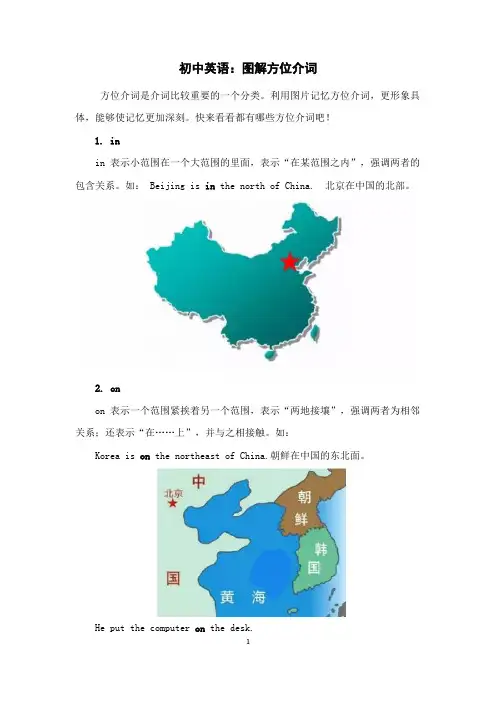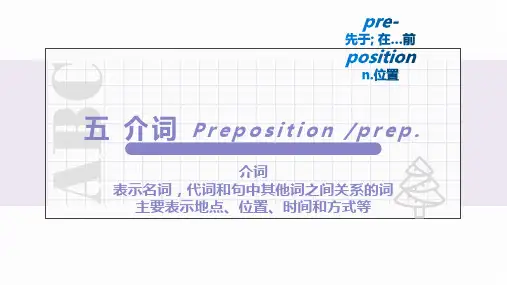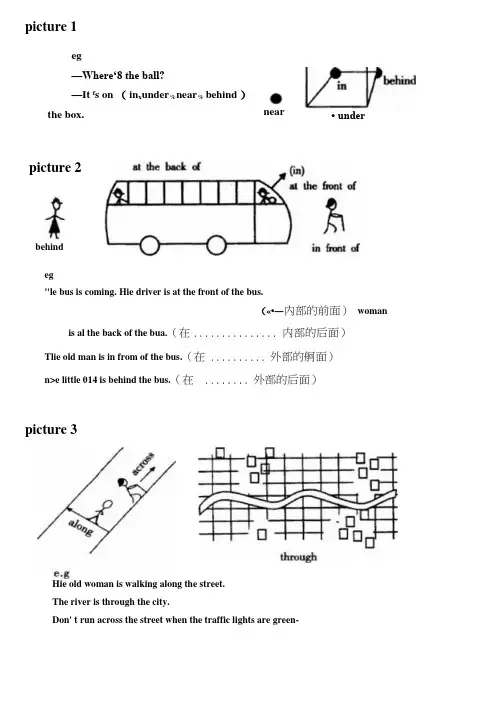英语介词用法图解
- 格式:ppt
- 大小:981.50 KB
- 文档页数:27

初中英语:图解方位介词方位介词是介词比较重要的一个分类。
利用图片记忆方位介词,更形象具体,能够使记忆更加深刻。
快来看看都有哪些方位介词吧!1. inin 表示小范围在一个大范围的里面,表示“在某范围之内”,强调两者的包含关系。
如: Beijing is in the north of China. 北京在中国的北部。
2. onon 表示一个范围紧挨着另一个范围,表示“两地接壤”,强调两者为相邻关系;还表示“在……上”,并与之相接触。
如:Korea is on the northeast of China.朝鲜在中国的东北面。
He put the computer on the desk.他把电脑放在桌子上。
3. toto 表示一个范围和另一个范围之间隔段距离,表示“在某范围之外”,强调两者是远离关系。
如:Japan is to the east of China. 日本位于中国的东边。
4. atat 表示在某地点,强调在某个位置点。
如:I met Mary at the school gate this morning.我今天早上在校门口遇见了玛丽。
5. under 和 belowunder表示“在……的正下方”,指垂直上下。
below表示“在……的下方”,只表示位置低于,但不是在正下方。
如:There is a cat under the table. 桌子下面有一只猫。
He saw many hills and rivers below the plane.他看见飞机的下方有许多小山和河流。
6. over 和 aboveover表示“在……垂直的上方”,与under相对;above表示“在……的上方”,指高于某物,但不是正上方,与below相对。
如:She is holding an umbrella over her head.她撑着一把伞遮头。
An airplane flew above the clouds.一架飞机在云端上面飞行。



picture 1eg—Where‘8 the ball?—It f s on ( in x under%near% behind )the box.eg"le bus is coming. Hie driver is at the front of the bus.(«•―内部的前面)woman is al the back of the bua.(在............... 内部的后面)Tlie old man is in from of the bus.(在.......... 外部的舸面)n>e little 014 is behind the bus.(在 ........ 外部的后面)picture 3Hie old woman is walking along the street.The river is through the city.Don' t run across the street when the traffic lights are green-picture 2behindnear • undereg'Hiere are many apples on the tree.(长在树上用“on”"Hiere is a cat in the tree.(停留在树上用“in"egThe plane flew above the clouds.(在......... 上方■不接键右直There is a light over the table.(在 ........ 正上方■不接傩表面)egLi lei walked into the house・(表动作)Then he was in the bouse.(表状态)After a while t he walked out of the hou»e ・(表动作)picture 4picture 6。






英语介词不知道用哪个?一张图帮你理解常用介词!学习英语除了单词需要记忆之外,很多动词词组的记忆也给人们带来了困扰,常用的英语介词有up、down、over、to、away from、past、into、out、out of、around、onto、across、off、through、along等,那么,这些介词到底是代表什么意思呢?English下面总结了一张图,把常用的介词用图展示了出来,看完这张图是不是对这些介词有了大概的理解了呢?常用介词Up是向上的意思,例如:get up举起、起床;stand up起立、树立。
Down是向下的意思,例如:get down下来、吞下、写下;go down下沉、停止。
Over是越过的意思,例如:get over渡过、克服;walk over穿过。
To是去到、向的意思,例如:go to奔赴、去;get to到达。
去旅游Away from是远离的意思,例如:keep away from避开、远离;get away from逃离。
Past是经过、越过、超过的意思,例如:go past经过;walk past走过、经过。
Into是进入的意思,例如:go into进入;put into投入。
Out/out of是出来、向外的意思,例如:walk out出走、离开;work out解决、作出。
Around是周围、环绕的意思,例如:walk around绕……走;see around参观。
转一转Onto是到……上去的意思,例如:fall onto掉到……上面,step onto踏上。
Across是从表面穿过的意思,例如:walk across步行穿过、横穿。
Off是下来、脱离的意思,例如:get off离开、下车;give off放弃。
Through是从内部穿过的意思,例如:get through度过、穿过;go through穿过、通过。
Along是沿着的意思,例如:walk along沿着……走;get along 前进、相处。